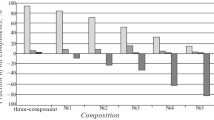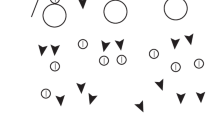Abstract
A 1.8 m×2.5 cm reciprocating-plate countercurrent extraction column was evaluated for the preparation of WSF (water-soluble fractions) from Flotta North Sea light crude oil. The energy input from the plate reciprocation speeds was found to be the main factor affecting the characteristics of the extracted WSF, and the throughputs of the stock solution or the ratio of seawater to crude oil had little effect on the concentration and composition of the extracted WSF. A combination of a reciprocation speed of 170 strokes/min, a seawater flow rate of 220 ml/min, and a crude oil flow rate of 2.9 ml/min produced a WSF stock solution with a total hydrocarbon concentration of 13.5±0.30 mg/kg (n=6) which was more reproducible than that made by a previously used large-scale batch extraction method. A settlement time of 5 h or less for the stock solution allowed a full separation of any dispersed droplets of crude oil from the aqueous phase under the above conditions, but further increases in reciprocation speeds caused difficulties in the final separation of this crude oil. The column extraction method was highly reproducible and gave a more concentrated WSF containing a higher proportion of alkanes than a WSF made by the batch extraction method. Low-boiling aromatics were the main components of the total extracted hydrocarbons of the WSF.
Similar content being viewed by others
References
Anderson JW, Neff JM, Cox BA, Tatem HE, Hightower GM (1974) Characteristics of dispersions and water-soluble extracts of crude and refined oils and their toxicity to estuarine crustaceans and fish. Mar Biol 27:75–88
Boylan DB, Tripp BW (1971) Determination of hydrocarbons in seawater extracts of crude oil and crude oil fractions. Nature 230:44–47
Burris DR, MacIntyre WG (1984) Water solubility behaviour of hydrocarbon mixtures—implications for petroleum dissolution. In: Vandermeulen JH, Hrudey SE (eds) Oil in freshwater: Chemistry, biology, countermeasure technology. Proceedings of the symposium of oil pollution in freshwater, Edmonton, Alberta, Canada. Pergamon Press, NY, pp 85–94
Clark RC (1977) Inputs, transport mechanisms, and observed concentrations of petroleum in the marine environment. In: Malins DC (ed) Effects of petroleum on arctic and subarctic marine environments and organisms, Vol I, Nature and fate of petroleum. Academic Press, NY, pp 91–223
Craddock DR (1977) Acute toxic effects of petroleum on arctic and subarctic marine organisms. In: Malins DC (ed) Effects of petroleum on arctic or subarctic marine environments and organisms, Vol II, Biological effects. Academic Press, NY, pp 1–94
Davis HK, Geelhoed EN, MacRae AW, Howgate P (1992) Sensory analysis of trout tainted by diesel fuel in ambient water. Water Sci Technol 25(2):11–18
Ernst R, Carter J, Ratnayake N (1989) Tainting and toxicity in sea scallops (Placopecten magellanicus) exposed to the water-soluble fraction of Scotian Shelf natural gas condensate, Report EE-116. Environment Canada, Conservation and Protection, Marine Environment Protection Branch, Ottawa, Canada
Goldberg WM (1973) Liquid-liquid and solid-solid systems. In: Perry RH, Chilton CH (eds) Chemical engineers' handbook. McGraw-Hill, NY, pp 21.1–21.29
Gordon DC, Keizer PD, Prouse NJ (1973) Laboratory studies of the accommodation of some crude and residual fuel oil in seawater. J Fish Res Board Can 30:1611–1618
Heras H, Ackman RG, Macpherson EJ (1992) Tainting of Atlantic salmon (Salmo salar) by petroleum hydrocarbons during a short-term exposure. Mar Pollut Bull 24:310–315
Johannessen KI (1983) A flow-through extraction and dosage system for long-term bioassays with water-soluble oil hydrocarbons. Mar Environ Res 9:123–129
Karr AE (1959) Performance of a reciprocating-plate extraction column. AIChE J 5:446–452
Katz LM (1973) The effect of water-soluble fraction of crude oil on larvae of the decapod crustacean Neopanope texana (Sayi). Environ Pollut 5:119–204
Keck RT, Heess RC, Wehmiller J, Maurer D (1978) Sublethal effects of the water-soluble fraction of Nigerian crude oil on the juvenile hard clams, Mercenaria mercenaria (Linne). Environ Pollut 15:109–119
Lee WY, Nicol LAC (1977) The effect of the water-soluble fractions of no. 2 fuel oil on the survival and behaviour of coastal and oceanic zooplankton. Environ Pollut 12:279–292
Lo TC, Karr AE (1972) Development of a laboratory-scale reciprocating plate extraction column. Ind Eng Chem Process Des Dev 4:495–501
Lockhart WL, Danell RW (1992) Field and experimental tainting of arctic freshwater fish by crude and refined petroleum products. In: Proceedings of the fifteenth arctic and marine oilspill program technical seminar, 10–12 June 1992, Edmonton, Alberta, Canada. Environment Canada, Ottawa, pp 763–771
Maher WA (1982) Preparation and characterization of water-soluble fractions of crude and refined oils for use in toxicity studies. Bull Environ Contam Toxicol 29:268–272
McAuliffe C (1966) Solubility in water of paraffin, cycloparaffin, olefin, acetylene, and aromatic hydrocarbons. J Phys Chem 70:1267–1275
Moles A, Rice SD, Korn S (1979) Sensitivity of Alaskan freshwater and anadromous fishes to Prudhoe Bay crude oil and benzene. Trans Am Fish Soc 108:408–414
Murray DAJ (1979) Rapid micro extraction procedure for analyses of trace amounts of organic compounds in water by gas chromatography and comparisons with macro extraction methods. J Chromatogr 177:135–140
Murray DAJ, Lockhart WL (1981) Microextraction and gas chromatographic analysis of selected petroleum hydrocarbons in water and fish tissue. J Chromatogr 212:305–311
Nunes P, Benville P (1978) Acute toxicity of the water-soluble fraction of Cook Inlet crude oil to the Manila clam. Mar Pollut Bull 9:324–331
Peake E, Hodgson GW (1966) Alkanes in aqueous systems. 1. exploratory investigation on the accommodation of C20-C33 n-alkanes in distilled water and occurrence in natural water systems. J Am Oil Chem Soc 43:215–222
Rice SD, Short JW, Kariene JF (1977) Comparative oil toxicity and comparative animal sensitivity. In: Wolfe DA (ed) Fate and effects of petroleum hydrocarbons in marine organisms and ecosystems. Pergamon Press, NY, pp 78–94
Shaw DG (1977) Hydrocarbons in the water column. In: Wolfe DA (ed) Fate and effects of petroleum hydrocarbons in marine organisms and ecosystems. Pergamon Press, NY, pp 8–18
Siron R, Rontani J-F, Giusti G (1987) Chemical characterization of a water-soluble fraction (WSF) of crude oil. Toxicol Environ Chem 15:223–229
Smith RL, Cameron JA (1979) Effect of water-soluble fraction of Prudhoe Bay crude oil on embryonic development of Pacific herring. Trans Am Fish Soc 108:70–75
Sutton C, Calder JA (1974) Solubility of higher-molecular-weight n-paraffins in distilled water and seawater. Environ Sci Technol 8:654–657
Treybal RE (1973) Liquid extraction. In: Perry RH, Chilton CH (eds) Chemical engineers' handbook. McGraw-Hill, NY, pp 15.1–15.24.
Vignier V, Vandermeulen JH, Fraser AJ (1992) Growth and food conversion by Atlantic salmon parr during 40 days' exposure to crude oil. Trans Am Fish Soc 121:322–332
Widdows J, Bakke T, Bayne BL, Donkin P, Livingstone DR, Lowe DM, Moore MN, Evans SV, Moore SL (1982) Responses of Mytilus edulis on exposure to the water-accommodated fraction of North Sea Oil. Mar Biol 67:15–31
Author information
Authors and Affiliations
Rights and permissions
About this article
Cite this article
Zhou, S., Heras, H. & Ackman, R.G. Preparation and characterization of a water-soluble fraction of crude oil by a Karr reciprocating-plate countercurrent extraction column. Arch. Environ. Contam. Toxicol. 26, 527–533 (1994). https://doi.org/10.1007/BF00214157
Received:
Revised:
Issue Date:
DOI: https://doi.org/10.1007/BF00214157




